
Stuttgart is the capital and largest city of the German state of Baden-Württemberg. It is located on the Neckar river in a fertile valley known locally as the "Stuttgart Cauldron" and lies an hour from the Swabian Jura and the Black Forest. Its area has a population of 605,997, making it the sixth largest city in Germany. 2.8 million people live in the city's administrative region and 5.3 million people in its metropolitan area, making it the fourth largest metropolitan area in Germany. The city and metropolitan area are consistently ranked among the top 20 European metropolitan areas by GDP; Mercer listed Stuttgart as 21st on its 2015 list of cities by quality of living, innovation agency 2thinknow ranked the city 24th globally out of 442 cities and the Globalization and World Cities Research Network ranked the city as a Beta-status global city in their 2014 survey. Stuttgart was one of the host cities for the official tournaments of the 1974 and 2006 FIFA World Cups.

Baden-Württemberg is a state (Land) in southwest Germany, east of the Rhine, which forms the southern part of Germany's western border with France. With more than 11 million inhabitants as of 2017 across a total area of nearly 35,752 km2 (13,804 sq mi), it is the third-largest German state by both area and population. As a federated state, Baden-Württemberg is a partly-sovereign parliamentary republic. The largest city in Baden-Württemberg is the state capital of Stuttgart, followed by Mannheim and Karlsruhe. Other cities are Freiburg im Breisgau, Heidelberg, Heilbronn, Pforzheim, Reutlingen, Tübingen, and Ulm.

Comburg (help·info) was a Benedictine monastery near Schwäbisch Hall in Baden-Württemberg in Germany.
Zanclodon is an extinct genus of archosauriform found in Middle Triassic deposits in southern Germany.

Termatosaurus is a genus of archosaur known from several specimens spanning two species. Its remains come from the Upper Triassic and was once thought to have survived until the Early Jurassic, but the Jurassic remains were redescribed as plesiosaur remains. It has only been found in France, England, Germany and Switzerland. and two species are known of this animal: the type species, Termatosaurus albertii, named by Meyer and T. Plieninger in 1844; and T. crocodilinus, by Quenstedt (1858). It is very obscure and apparently considered to be dubious.
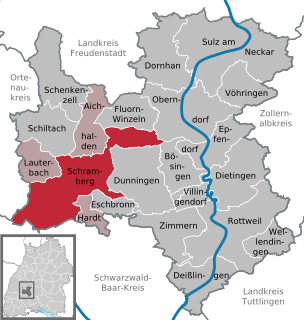
Schramberg is a town in the district of Rottweil, in Baden-Württemberg, Germany. It is situated in the eastern Black Forest, 25 km northwest of Rottweil. With all of its districts, it has about 22,000 inhabitants.

Thalattosuchia is the name given to a clade of marine crocodylomorphs from the Early Jurassic to the Early Cretaceous that had a cosmopolitan distribution. They are colloquially referred to as marine crocodiles or sea crocodiles, though they are not members of Crocodilia.
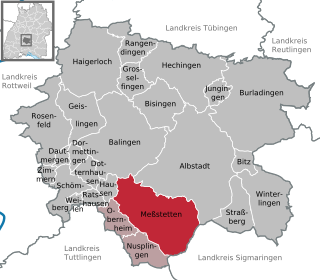
Meßstetten is a town in the Zollernalbkreis district, in Baden-Württemberg, Germany. It is situated in the Swabian Jura, 24 km southeast of Balingen. It is close to the Heuberg Training Area with the Lager Heuberg. Within the Heuberg Training Area there is the legendary Dreibannmarke, also called the "Bahn", a 17th-century border, which today marks the border between three different municipalities, formerly in the three states of Württemberg, Baden, and Hohenzollern. The meadow at the Dreibannmarke served as a stopping place for traveling merchants, wagons and craftsmen. With care it is possible to identify traces of the border. After the inauguration of the firing ranges, a meadow in Meßstetten was allocated as a camping site at the edge of the restricted area. Until 1835 merchandise was smuggled over the customs borders guarded by local hunters. Coffee smuggler Haux had was killed on 21 July 1831 in Pfaffental.

Geislingen is a town in the Zollernalbkreis district of Baden-Württemberg, Germany. It is situated 4 km northwest of Balingen. The population stands at roughly 6,000. Geislingen includes three smaller towns, Geislingen, Erlaheim, and Binsdorf, all of them growing about 1% per year. The area has been continuously settled since the Stone Age. The first written documentation of Binsdorf came in 834, Geislingen was officially mentioned in 1188. The local economy mixes agriculture with services and small-scale industry. Many residents work in industrial areas south of Stuttgart or in nearby Balingen.

"Rhamphocephalus" is an extinct genus of fossil reptile from the Middle Jurassic Great Oolite Group of Gloucestershire, England. The name was erected as a genus of pterosaur and became a 'wastebasket taxon' for British Jurassic pterosaur remains until a recent revision. Rhamphocephalus comprises several named species, two of which are pterosaurian, but the type species - "R. prestwichi" - is based on remains now identified as a thalattosuchian. Because it is poorly preserved and lacks features that distinguish it from other thalattosuchians, "R. prestwichi" is considered an invalid species and the genus Rhamphocephalus is a nomen dubium. Reassessments of other "Rhamphocephalus" species suggest they are also undiagnostic to species level, although they have properties allowing referral to some Jurassic pterosaur groups.

Au is a municipality in Breisgau-Hochschwarzwald, Baden-Württemberg, Germany. It is located a few kilometres south of Freiburg im Breisgau, in the south-western part of Baden-Württemberg. The municipality belongs to the administrative region of Hexental based in the neighbouring town of Merzhausen.

Eberhard I of Württemberg. From 1459 to 1495 he was Count Eberhard V, and from July 1495 he was the first Duke of Württemberg. He is also known as Eberhard im Bart.
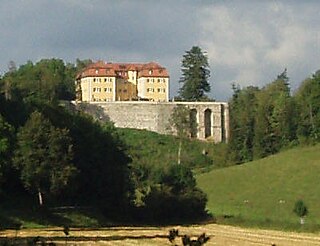
The Grafeneck Euthanasia Centre housed in Grafeneck Castle was one of Nazi Germany's killing centres as part of their forced euthanasia programme. Today, it is a memorial site dedicated to the victims of the state-authorised programme also referred to since as Action T4. At least 10,500 mentally and physically disabled people, predominantly from Bavaria and Baden-Württemberg, were systematically killed during 1940. It was one of the first places in Nazi Germany where people were killed in large numbers in a gas chamber using carbon monoxide. This was actually the beginning of the Euthanasia Programme. Here was also settled the central office of "Charitable Ambulance Transport GmbH" (Gekrat), which was responsible for the transport of T4 and was headed by Reinhold Vorberg.

Ottenhöfen im Schwarzwald is a town in the district of Ortenau in Baden-Württemberg in Germany.

The Trossingen Formation, formerly the Knollenmergel, is a geological formation in Germany and Switzerland. It dates back to the late Norian-Rhaetian.
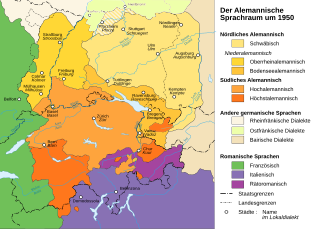
Alemannic Separatism is a historical movement of separatism of the Alemannic-German-speaking areas of Germany, France and Austria, aiming at a unification with the Swiss Confederacy. The historic origins of the movement lay in the Napoleonic era and it was briefly revived both after the end of World War I (1919) and after the end of World War II (1946–1952).
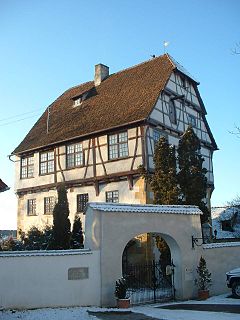
Alberweiler Castle is a small castle-like structure in the village of Alberweiler, now part of the municipality of Schemmerhofen in the state of Baden-Württemberg, Germany. It is situated on a hillside in the centre of the village. The ground and the first floor of the castle are made of stone whereas the upper storeys consist of three projecting half-timbered floors.
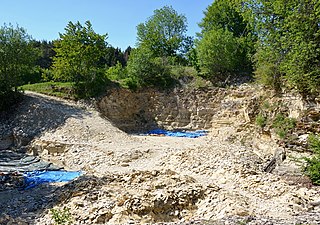
The Nusplingen Limestone is a geological formation in Baden-Württemberg, Germany. It preserves fossils dating to the Kimmeridgian age of the Late Jurassic. It mainly consists of lithographic limestones deposited in a marine basin, similar to the Solnhofen Limestone. Fossils of pterosaurs, thalattosuchians, and the oldest geophilomorph centipede Eogeophilus were found in the Nusplingen Limestone.
The Alb Limes is a Roman frontier fortification or limes of the late 1st century AD in the Swabian Jura, also known as the Swabian Alb. The Alb Limes runs for just under 135 kilometres from Rottweil in the southwest to Heidenheim an der Brenz in the northeast.

The Posidonia Shale or Posidonienschiefer Formation is a geological formation of southwestern Germany, northern Switzerland, northwestern Austria, southeast Luxembourg and the Netherlands, that spans about 3 million years during the Early Jurassic period. It is known for its detailed fossils, especially sea fauna, listed below. Composed mostly by black shale, the formation is a Lagerstätte, where fossils show exceptional preservation, with a thickness that varies from about 1 m to about 40 m on the Rhine level, being on the main quarry at Holzmaden between 5 and 14 m. Some of the preserved material has been transformed into fossil hydrocarbon Jet, specially wood remains, used for jewelry. The exceptional preservation seen on the Posidonia Shale has been studied since the late 1800s, finding that a cocktail of chemical and environmental factors let to such an impressive conservation of the marine fauna. The most common theory is the changes on the oxygen level, where the different anoxic events of the Toarcian left oxygen-depleted bottom waters, with the biota dying and falling to the bottom without any predator able to eat the dead bodies.


















